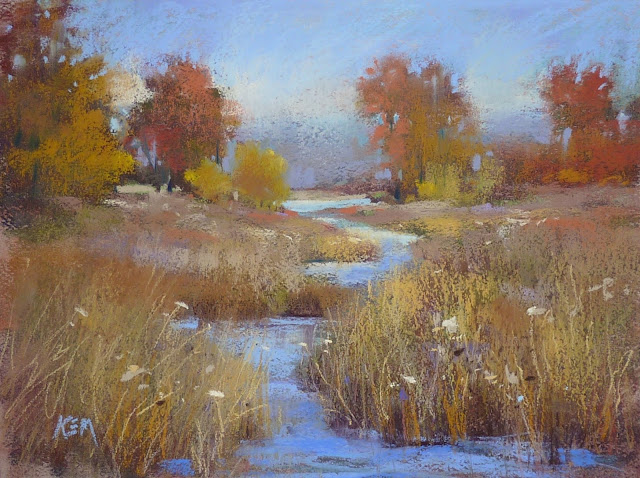 |
| 'Time for a Change' 8x10 pastel ©Karen Margulis available $125 |
But today I was reminded of yet another reason to embrace pastels.
Pastel is a very forgiving medium.
If you aren't happy with a painting it is very easy to make corrections. There is no such thing as the point of no return with a pastel painting. There are always ways to revive a painting gone bad. (I have done my fair share of putting this to the test!) You can even paint over a painting without having to scrape or wait for it to dry. It is the perfect medium for impatient artists like myself.
 |
| The 'before' painting.....when it was still summertime |
This is where I fell in love all over again with pastels. I could easily change the painting. Why not just change the season from summer to fall? All I had to do was give it a quick spray of workable fixative and start painting. Soon the summertime became autumn with a few layers of yellows and orange.
How to make corrections to a pastel painting
- Brush the bad parts out with a stiff bristle brush
- Use canned air to remove pastel more precisely
- Use a brush and running water to wash off a painting on some surfaces. I have been successful on Uart and Pastelbord
- Remove pastel with a chamois cloth (I have been told it works well on Pastelmat)
- liquify the bad parts or whole painting with a brush and water or rubbing alcohol of odorless mineral spirits creating a wet wash.
- spray the painting with workable fixative to restore some tooth allowing for more pastel layers.
- Add some clear gesso to make an underpainting with tooth. The pastel will turn into paint...usually some shade of gray.
How do you make corrections to a pastel? Please share your ideas in the comments. I would love to hear from you!

4 comments:
If the painting is really not worth saving, I'll rinse under the faucet. If it is just the matter of reworking the foreground I'll spray with water or alcohol. Of course these ideas I have learned from you Karen. Thanks.
Hi, Karen, in addition to the methods you've listed I use Mr. Magic cleaning eraser (the original one without the ridges.) I cut it into 1" cubes and use it to brush off the pastel. I can use the sides for larger areas and the points for tiny details. Works great, it's cheap and easy to find, and lasts a long time!
It's interesting. I don't heavily overwork pastels so if I make changes I'll usually layer over what I have, maybe blend what's under an area to add more layers. But I'm aware I could brush out or wipe out that easily and it gives me confidence to know that.
What's weird is that sometimes all it takes is half a dozen strokes to transform it. Sometimes I don't see the final strokes till weeks later.
Hi Karen,
Firstly I'd like to mention that I've been following you for a while, and I always appreciate your input. I particularly enjoyed watching your live video demos and therfore visiting your studio :)
Anyway, my tip for reworking a failed/overworked pastel painting is to sprinkle baking soda (bicarbonate of soda) over the painting. Let it sit for about 5mins, then lightly agitate with a soft brush. I like a babies hair brush because it does the job well without damaging the tooth on the paper.
You'll find that miraculously, the baking soda absorbs most of the pastel pigment and so when after brushing in soft circular movements for a while, when you get to brush it all off, the baking soda is saturated with color and very little is left on the paper.
Regards
Rowena
Post a Comment